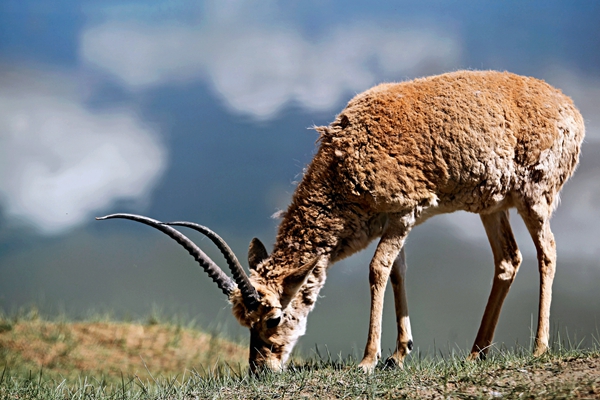The Tibetan Antelope
China Today by Jane Lu ,January 16, 2018 Adjust font size:
Editor’s note: Due to its broad territory and diverse natural environment, China is home to the widest range of wildlife species with 6,266 kinds of vertebrates, including 2,404 kinds of terrestrial animals and 3,862 kinds of fish, which make up nearly 10 percent of the world’s vertebrates. The giant panda, the snub-nosed monkey, the South China tiger, the brown-eared pheasant, the red-crowned crane, the crested ibis, the white-flag dolphin, and the Chinese alligator are some of China’s rare species of wild animals. This year, we have created a column to introduce some of these animals.
The Tibetan antelope inhabits the harsh steppe areas at an elevation of 4,000 to 6,000 km, and is under China’s highest level of protection. The government has established three national nature reserves in Tibet, Qinghai, and Xinjiang. The locations are around the Kunlun Mountains and Altun Mountain in Western China, among which Hoh Xil in Qinghai Province is the best known.
The lifespan of a Tibetan antelope is about eight years on average. A mother antelope, around two years of age, usually breeds for the first time and a single cub is born. Mating occurs in November and December. The gestation lasts for seven to eight months. Every summer pregnant females travel along fixed routes to Hoh Xil to give birth, where grass and water are plenty while natural enemies are few, especially around the Drone Lake and Taiyang Lake. The rich variety of food and relatively safe environment are favorable for breeding and raising baby antelopes. Soon afterwards, the females make the return journey together with their babies. It was not a few years ago that grand scenes of mass migration of about 2,000 Tibetan antelopes could be seen.

The Tibetan antelope is timid by nature, and can run at a speed of 80 km per hour. Male antelopes are also called unicorns in China, as their symmetrical angles look like a single horn from afar. They have developed thick underfur for the harsh climate.
There used to be millions of Tibetan antelopes according to historical records, but the population had plummeted since the 1990s and dropped to about 50,000 to 75,000 in the mid-1990s. People could only see scattered antelopes in the previously densely populated areas. Therefore, it was listed among the first-class protected species under the National Wildlife Protection Law. Hunting and trade are strictly forbidden. In 2008, it was listed as an endangered species on the Red List of Threatened Species by the International Union for the Conservation of Nature and Natural Resources (IUCN).
One reason to account for this is the more occurrences of extreme weather. The antelopes, especially females and the young, are susceptible to death in the freezing cold weather.